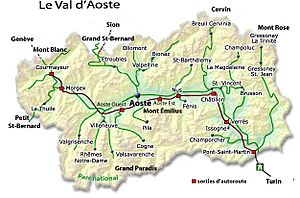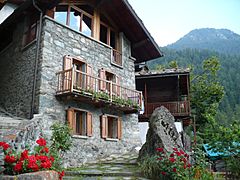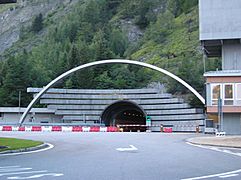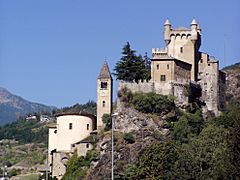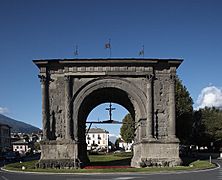Valle d'Aosta facts for kids
Quick facts for kids
Aosta Valley
Valle d'Aosta - Vallée d'Aoste
|
|||
|---|---|---|---|
|
|||
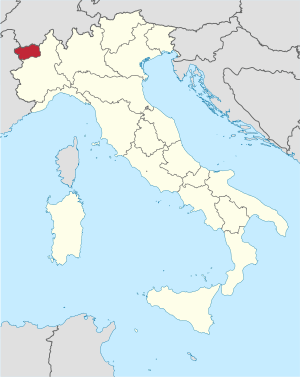 |
|||
| Country | Italy | ||
| Capital | Aosta | ||
| Area | |||
| • Total | 3,260.90 km2 (1,259.04 sq mi) | ||
| Population
(1 January 2017)
|
|||
| • Total | 126,883 | ||
| • Density | 38.91042/km2 (100.7775/sq mi) | ||
| Time zone | UTC+1 (CET) | ||
| • Summer (DST) | UTC+2 (CEST) | ||
| GDP/ Nominal | € 4.3 billion (2010) | ||
| GDP per capita | € 30,300 (2008) | ||
| NUTS Region | ITC (Northwestern Italy) | ||
| Website | www.regione.vda.it | ||
Valle d'Aosta (Italian: Valle d'Aosta (official) or Val d'Aosta (usual), French: Vallée d'Aoste (official) or Val d'Aoste (usual)) is a mountainous region in northwestern Italy. In English is common to call it Aosta Valley.
The region has two official name: Regione Autonoma Valle d'Aosta (in Italian) and Région Autonome Vallée d'Aoste (in French). The capital is Aosta.
This is the smallest region in Italy with an area of 3,260.9 km2 (1,259.0 sq mi), and a population of about 126,883. It is the only Italian region which has no provinces. The regional government has taken all the administrative functions of a province. The region is divided into 74 comuni.
Contents
Limits
It limits to the north with Switzerland (Canton Valais), to the west with France (region Auvergne-Rhône-Alpes), to the south and east with the Italian region of Piedmont.
Geography
The Valle d'Aosta is a small valley, the valley of the Dora Baltea river, with some smaller side valleys, in the middle of the Alps, surrounded by four of the tallest mountains throughout Italy and Europe:
- Mont Blanc; height: 4,810 m (15,781 ft) (45°50′01″N 6°51′54″E / 45.83361°N 6.86500°E), the highest mountain in the Alps.
- Matterhorn (German), Monte Cervino (Italian) or Mont Cervin (French); height: 4,478 m (14,692 ft) (45°58′35″N 7°39′30″E / 45.97639°N 7.65833°E)
- Monte Rosa; height: 4,634 m (15,203 ft) (45°56′12.6″N 7°52′01.4″E / 45.936833°N 7.867056°E), the second highest mountain in the Alps.
- Gran Paradiso; height: 4,061 m (13,323 ft) (45°32′0″N 7°16′0″E / 45.53333°N 7.26667°E).
In the Valle d'Aosta, a region with many mountainous and close to borders with other countries, the mountain passes are very important. Even if now there some tunnels, they are important not only from a historical and geographical perspective, but also traditional and tourism.
The main mountain passes between the Val d'Aosta and other valleys are:
- The Little St Bernard Pass (French: Col du Petit Saint-Bernard; Italian: Colle del Piccolo San Bernardo), between Savoie, France and the Valle d'Aosta;
- The Great St Bernard Pass (French: Col du Grand Saint-Bernard; Italian: Colle del Gran San Bernardo), between Valais, Switzerland and the Valle d'Aosta;.
The southern part of the territory is occupied by the Gran Paradiso National Park, created in 1922 to protect plants and animals in danger of extinction.
The valleys were made by glaciers moving at a time when the entire region was covered by them. Currently, glaciers occupy only the highest peaks.
The Dora Baltea (French: Doire Baltée) river flows along the whole Valle d'Aosta, from the northwest to the southeast; it is 160 km (99 mi) long and is a tributary of the Po river.
Mountain Communities
The 74 comuni - with the exception of Aosta - of the Valle d'Aosta are organized in mountain communities (Italian: Comunità montane, French: Communautés de montagne). There are 8 mountain communities:
| Mountain Community | Capital | Comuni |
|---|---|---|
| Evançon | Verrès | 9 |
| Grand Combin | Gignod | 11 |
| Grand Paradis | Villeneuve | 13 |
| Mont Emilius | Quart | 10 |
| Mont Rose | Pont-Saint-Martin | 9 |
| Monte Cervino | Châtillon | 12 |
| Valdigne Mont Blanc | La Salle | 5 |
| Walser - Alta Valle del Lys | Issime | 4 |
Comuni with higher populations
The 10 comuni of the Valle d'Aosta with the higher populations (January 2017) are:
| No. | City | Population (2017) |
Area (km2) |
Density (inh./km2) |
Altitude (m) |
|---|---|---|---|---|---|
| 1 | Aosta | 34,361 | 21.39 | 1,606.4 | 583 |
| 2 | Sarre | 4,887 | 28.28 | 172.8 | 625 |
| 3 | Châtillon | 4,753 | 39.68 | 119.8 | 549 |
| 4 | Saint-Vincent | 4,620 | 20.57 | 224.6 | 575 |
| 5 | Quart | 4,061 | 62.05 | 65.4 | 535 |
| 6 | Pont-Saint-Martin | 3,833 | 6.92 | 553.9 | 345 |
| 7 | Saint-Christophe | 3,441 | 14.74 | 233.4 | 619 |
| 8 | Gressan | 3,398 | 25.30 | 134.3 | 626 |
| 9 | Saint-Pierre | 3,191 | 26.18 | 121.9 | 676 |
| 10 | Nus | 2,979 | 57.36 | 51.9 | 529 |
People
A person from the Valle d'Aosta is called a Valdotian (Italian: Valdostano/a, French: Valdôtain).
Population
The total population of Valle d'Aosta in 1 January 2017 was 126,883, of which 61,976 were male and 64,907 were female.
Evolution of the population in the Aosta Valley
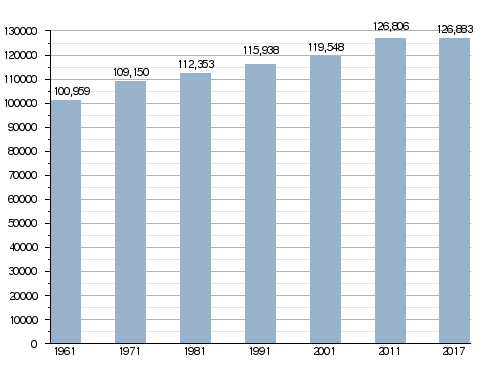
Languages
Italian and French are the region's official languages and are used for the regional government's acts and laws, though Italian is much more widely spoken in everyday life. Of the population of the valley 96% speaks Italian as either a first or second language. Of the population 70% speaks French as either first or second language. School education is given equally in both Italian and French.
The regional language is a dialect of Franco-Provençal called Valdôtain (locally, patois). It is spoken as native tongue and as second language by about 58% of the population, according to a poll taken by the Fondation Émile Chanoux in 2002. The residents of the villages of Gressoney-Saint-Jean, Gressoney-La-Trinité and Issime, in the Lys Valley, speak two dialects of Walser German origin called Titsch and Töitschu respectively.
Gallery
-
View of the city of Aosta
-
Mont Blanc Tunnel entrance.
Images for kids
-
Bleu Lake and the Matterhorn
-
The prehistoric site near Chenal castle, Montjovet, rich in petroglyphs
-
Alpine marmot in Gran Paradiso National Park
See also
 In Spanish: Valle de Aosta para niños
In Spanish: Valle de Aosta para niños




